newspaper

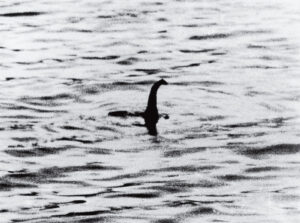 Over the years, I think most people have heard of the Loch Ness Monster. Most people have formed their own opinions as to what the monster, dubbed “Nessy” was. Many people have called it a hoax. Others have said that people imagined it. Still others thought it was a big fish or just a log. Whatever it was or is, the legend has endured for a long time now. In fact, the first “sighting” was reported on May 2, 1933. When the news broke, the newspaper, Inverness Courier told of a local couple who told of “an enormous animal rolling and plunging on the surface.” The story of the “monster” which was added by the Courier editor, becomes a media phenomenon, with London newspapers sending correspondents to Scotland and a circus offering a 20,000 pound sterling reward for capture of the beast.
Over the years, I think most people have heard of the Loch Ness Monster. Most people have formed their own opinions as to what the monster, dubbed “Nessy” was. Many people have called it a hoax. Others have said that people imagined it. Still others thought it was a big fish or just a log. Whatever it was or is, the legend has endured for a long time now. In fact, the first “sighting” was reported on May 2, 1933. When the news broke, the newspaper, Inverness Courier told of a local couple who told of “an enormous animal rolling and plunging on the surface.” The story of the “monster” which was added by the Courier editor, becomes a media phenomenon, with London newspapers sending correspondents to Scotland and a circus offering a 20,000 pound sterling reward for capture of the beast.
The sighting, which actually occurred in April 1933 sighting was reported in the newspaper on May 2nd. After that, interest steadily grew, especially after another couple claimed to have seen the animal on land. I don’t  recall ever having heard of the Loch Ness Monster being seen on land, but I suppose that if it is real, it could be seen on land too. What is really amazing, however, is the fact that the story, real, imagined, or faked, has endured through the years…90 of them to be exact.
recall ever having heard of the Loch Ness Monster being seen on land, but I suppose that if it is real, it could be seen on land too. What is really amazing, however, is the fact that the story, real, imagined, or faked, has endured through the years…90 of them to be exact.
Since the first sighting, amateur “investigators” have for kept an almost constant vigil, and in the 1960s several British universities launched sonar expeditions to the lake. None of the universities found anything conclusive, however, in each expedition the sonar operators detected something large, moving under the water. Still, they couldn’t identify the objects they saw. In 1975, another expedition combined sonar and underwater photography in Loch Ness. A photo resulted that, after enhancement, appeared to show what vaguely resembled the giant flipper of an aquatic animal. Nevertheless, the people who participated in the expeditions believed that there was something there, and they had no reason not to believe that the “monster” often called “Nessy” was real. So, the speculation continued.
In the 1980s and the 1990s, additional sonar expeditions were conducted. These also brought inconclusive 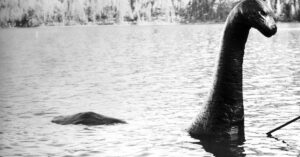
 readings. It was revealed in 1994 that the now famous 1934 photo was a complete hoax, but people still believed. It did little to dampen enthusiasm of tourists and investigators for the legendary beast of Loch Ness. The search continues to this day.
readings. It was revealed in 1994 that the now famous 1934 photo was a complete hoax, but people still believed. It did little to dampen enthusiasm of tourists and investigators for the legendary beast of Loch Ness. The search continues to this day.
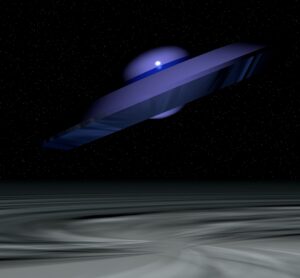
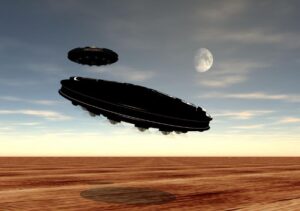 Seventy-five years ago, people began seeing and having an interest in seeing Unidentified Flying Objects (UFOs). A place called Roswell, New Mexico became famous for UFO sightings, and the Air Force found itself denying any sightings. People who saw the UFOs maintained that they “know what they saw!” Roswell, New Mexico is located near the Pecos River in the southeastern part of the state. Roswell became a magnet for UFO believers due to the strange events of early July 1947, when ranch foreman W.W. Brazel found a strange, shiny material scattered over some of his land. It was like nothing he or anyone else had ever seen before.
Seventy-five years ago, people began seeing and having an interest in seeing Unidentified Flying Objects (UFOs). A place called Roswell, New Mexico became famous for UFO sightings, and the Air Force found itself denying any sightings. People who saw the UFOs maintained that they “know what they saw!” Roswell, New Mexico is located near the Pecos River in the southeastern part of the state. Roswell became a magnet for UFO believers due to the strange events of early July 1947, when ranch foreman W.W. Brazel found a strange, shiny material scattered over some of his land. It was like nothing he or anyone else had ever seen before.
I’m not one to believe in UFOs, but I must admit that these were unusual sightings. Public interest in Unidentified Flying Objects, or UFOs, began to flourish in the 1940s, when developments in space travel and the dawn of the atomic age caused many Americans to turn their attention to the skies. Brazel turned the material over to the sheriff, who passed it on to authorities at the nearby Air Force base. Not unexpectedly, the Air Force officials announced they had recovered the wreckage of a “flying disk.” A local newspaper put the story on its front page, launching Roswell into the spotlight of the public’s UFO fascination. I’m sure the newspaper was beyond excited to get the story, because a good story is great for selling newspapers…especially when it is unbelievable.
Of course, in typical government style, the Air Force took back their story, saying the debris had been merely a downed weather balloon. After that, the general public lost interest in the UFO, except for the die-hard UFO believers, nicknamed “ufologists.” With that, the “Roswell Incident” faded into oblivion…until the late 1970s. Then, claims surfaced that the military had invented the weather balloon story as a cover-up. Of course, these would be considered the conspiracy theorists of their day. Believers in this theory insisted that officials had retrieved several alien bodies from the crashed spacecraft, which were now stored in the mysterious Area 51 installation in Nevada. Now, the Air Force had clean-up to do. Seeking to dispel these suspicions, the Air Force issued a 1,000-page report in 1994 stating that “the crashed object was actually a high-altitude weather balloon launched from a nearby missile test-site as part of a classified experiment aimed at monitoring the atmosphere in order to detect Soviet nuclear tests.” Then on June 24, 1997, US Air Force officials release a 231-page report dismissing long-standing claims of an alien spacecraft crash in Roswell, New Mexico, almost exactly 50 years earlier.
Many people have heard this story, of course, and Area 51 remains a mystery to many people to this day. Most think that the whole thing was a hoax or a weather balloon, but now…suddenly, NASA has decided to take up the study of UFOs…seriously!! See, that, to me, seems more like a conspiracy theory or at the very least a way to take our minds off of other events going on in our world today, than it is a legitimate search for UFOs or 
 anything else. According to a story by The Sun, on May 27, 2022, “NASA has reportedly confirmed it will officially join the hunt for UFOs after a groundbreaking UAP Congress hearing earlier this month. Unidentified Aerial Phenomena (UAPs) and official sightings were recently discussed at a public US Congress hearing on May 17. Nasa had previously said it “does not actively search for” or research UAPs.” What a way to spend our money…and why now, after all these years.
anything else. According to a story by The Sun, on May 27, 2022, “NASA has reportedly confirmed it will officially join the hunt for UFOs after a groundbreaking UAP Congress hearing earlier this month. Unidentified Aerial Phenomena (UAPs) and official sightings were recently discussed at a public US Congress hearing on May 17. Nasa had previously said it “does not actively search for” or research UAPs.” What a way to spend our money…and why now, after all these years.
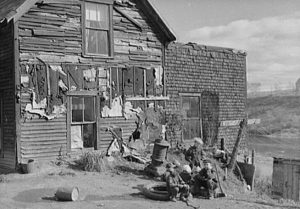 When the Great Depression hit, people in the upper-middle class, like doctors, lawyers, and other professionals, saw their incomes drop by 40%, but the middle class and low income Americans found themselves with nothing. They had no jobs and no money, and even if they did have those things, they couldn’t afford the things they needed. The prices for everything from food to clothing were much more than their meager income could buy much of. People began to move from place to place looking for a job…any job. The problem was that there were very few jobs, and lot of people standing in line to get them. The average American lived by the Depression-era motto: Use it up, wear it out, make do, or do without. People had to learn to be frugal. Clothes were patched when the started to wear out. People planted gardens and even kept little gardens in their kitchen. They stayed home, instead of evenings out. They were always in a private struggle to keep their cars or homes.
When the Great Depression hit, people in the upper-middle class, like doctors, lawyers, and other professionals, saw their incomes drop by 40%, but the middle class and low income Americans found themselves with nothing. They had no jobs and no money, and even if they did have those things, they couldn’t afford the things they needed. The prices for everything from food to clothing were much more than their meager income could buy much of. People began to move from place to place looking for a job…any job. The problem was that there were very few jobs, and lot of people standing in line to get them. The average American lived by the Depression-era motto: Use it up, wear it out, make do, or do without. People had to learn to be frugal. Clothes were patched when the started to wear out. People planted gardens and even kept little gardens in their kitchen. They stayed home, instead of evenings out. They were always in a private struggle to keep their cars or homes.
Paint was too expensive, so home fell into disrepair. As things got worse, things began to wear out, and people didn’t get rid of the junk. They simply put it out in the yard. I’m sure that they realized that every piece of junk had parts in it that could be used for repairs to something else. Everything could be reworked. They used the  backs of worn-out overall legs to make pants for little boys and overalls for babies. They didn’t have disposable diapers back then. They made diapers and underwear out of flour and sugar sacks. When the older kids outgrew their clothes, but they were too big for the younger kids, they made smaller clothes out of bigger hand-me-downs. If their shoes wore out before a year, the children went barefooted. Many people resorted to bartering…not only goods for goods, but work for work. They tried to make their homes and their lives pretty, even in depressing times. They used patterned chicken feed sacks to make curtains, aprons, and little girl’s dresses. Worn out socks were kept, so that they could patch another sock. Nothing was thrown away. They saved string that came loose from clothing and added it to a string ball for mending and sewing. Toilet paper was a luxury that many people couldn’t afford, so they used newspaper instead. They saved every scrap of material for making quilts. People learned not to waste anything.
backs of worn-out overall legs to make pants for little boys and overalls for babies. They didn’t have disposable diapers back then. They made diapers and underwear out of flour and sugar sacks. When the older kids outgrew their clothes, but they were too big for the younger kids, they made smaller clothes out of bigger hand-me-downs. If their shoes wore out before a year, the children went barefooted. Many people resorted to bartering…not only goods for goods, but work for work. They tried to make their homes and their lives pretty, even in depressing times. They used patterned chicken feed sacks to make curtains, aprons, and little girl’s dresses. Worn out socks were kept, so that they could patch another sock. Nothing was thrown away. They saved string that came loose from clothing and added it to a string ball for mending and sewing. Toilet paper was a luxury that many people couldn’t afford, so they used newspaper instead. They saved every scrap of material for making quilts. People learned not to waste anything.
Every part of the food was used. Potato peels were food, not waste. They made soup out of a few vegetables and a scrap of meat…for flavor only. They hunted for rabbits and fished to put what protein they could on the table. When there was nothing more to eat, they had lard sandwiches. I seriously doubt if many people went to  bed with a full stomach, but that didn’t mean that you turned away a stranger who was hungry. These people knew hw bad things were for them, and so they helped their neighbors. Nevertheless, during the Great Depression, suicide rates in the United States reached an all-time high, topping 22 suicides per 100,000 people. The living conditions were deplorable, and many people couldn’t take it. They felt that somehow they were at fault. still, for the majority of Americans, that didn’t mean that they gave up. Neighbor looked out for neighbor, and families came together to support each other, and while the effects of the Great Depression lasted for 12 years, this too passed, and the nation healed again.
bed with a full stomach, but that didn’t mean that you turned away a stranger who was hungry. These people knew hw bad things were for them, and so they helped their neighbors. Nevertheless, during the Great Depression, suicide rates in the United States reached an all-time high, topping 22 suicides per 100,000 people. The living conditions were deplorable, and many people couldn’t take it. They felt that somehow they were at fault. still, for the majority of Americans, that didn’t mean that they gave up. Neighbor looked out for neighbor, and families came together to support each other, and while the effects of the Great Depression lasted for 12 years, this too passed, and the nation healed again.
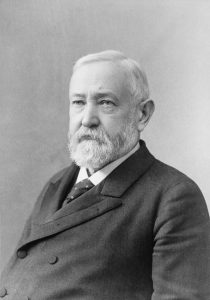 Sometimes, a business starts up and then can’t make a go of it. Whatever the reason, things just don’t work out. Such was the case with a 1690 newspaper called Publick Occurrences Both Forreign and Domestick. This newspaper was published for the first and last time on September 25, 1690, making it the shortest business on record.
Sometimes, a business starts up and then can’t make a go of it. Whatever the reason, things just don’t work out. Such was the case with a 1690 newspaper called Publick Occurrences Both Forreign and Domestick. This newspaper was published for the first and last time on September 25, 1690, making it the shortest business on record.
It would seem like such a business venture wouldn’t hold a very significant place in history, but it did have one distinction that gave it an important place. It was the first multi-page newspaper published in the Americas. Before then, single-page newspapers, called broadsides, were published in the English colonies and printed in Cambridge in 1689. The first edition of Publick Occurrences was published in Boston, then a city in the Dominion of New England, and was intended to be published monthly, “or, if any Glut of Occurrences happen, oftener.” It was printed by American Richard Pierce of Boston, and it was edited by Benjamin Harris, who had previously published a newspaper in London. The paper contained four 6 by 10 inch pages, but filled only three of them…not bad for a new newspaper.
The second edition was never printed because the paper was shut down by the Colonial government on September 29, 1690, who issued an order as follows: “Whereas some have lately presumed to Print and Disperse a Pamphlet, 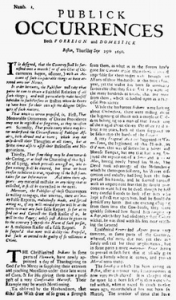 Entitled, Publick Occurrences, both Forreign and Domestick: Boston, Thursday, September 25th, 1690. Without the least Privity and Countenace of Authority. The Governour and Council having had the perusal of said Pamphlet, and finding that therein contained Reflections of a very high nature: As also sundry doubtful and uncertain Reports, do hereby manifest and declare their high Resentment and Disallowance of said Pamphlet, and Order that the same be Suppressed and called in; strickly forbidden any person or persons for the future to Set forth any thing in Print without License first obtained from those that are or shall be appointed by the Government to grant the same.”
Entitled, Publick Occurrences, both Forreign and Domestick: Boston, Thursday, September 25th, 1690. Without the least Privity and Countenace of Authority. The Governour and Council having had the perusal of said Pamphlet, and finding that therein contained Reflections of a very high nature: As also sundry doubtful and uncertain Reports, do hereby manifest and declare their high Resentment and Disallowance of said Pamphlet, and Order that the same be Suppressed and called in; strickly forbidden any person or persons for the future to Set forth any thing in Print without License first obtained from those that are or shall be appointed by the Government to grant the same.”
Of course, in those days, we were not an independent nation, and the Constitution did not exist. Freedom of the press…or any of the other freedoms that our soldiers and our nation have fought to give us, didn’t exist either. England was the ruler and the law, and we had to obey…for a time. Soon enough, change would come, as would freedom, and every kind of newspaper and other types of information sources imaginable.

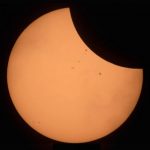 With yesterday’s eclipse, came a massive amount of videos and photos documenting the event. Before it was even over, people all over the world were able to view the event. NASA filmed it and posted it on their website…including the moments when the International Space Station flew in front of it!! It was an awesome way for people, who were unable to get to the path of totality, to view the event. While we give little thought to such abilities today, just a few years back, they would have seemed impossible, or at the very least, they would have shocked us. That’s because we have things like television, internet, cell phones, and digital cameras…but they didn’t then. The television was looked upon as a fad that would never take hold. People simply wouldn’t spend the money on one. How very wrong they were.
With yesterday’s eclipse, came a massive amount of videos and photos documenting the event. Before it was even over, people all over the world were able to view the event. NASA filmed it and posted it on their website…including the moments when the International Space Station flew in front of it!! It was an awesome way for people, who were unable to get to the path of totality, to view the event. While we give little thought to such abilities today, just a few years back, they would have seemed impossible, or at the very least, they would have shocked us. That’s because we have things like television, internet, cell phones, and digital cameras…but they didn’t then. The television was looked upon as a fad that would never take hold. People simply wouldn’t spend the money on one. How very wrong they were.
Lets travel back in time to when television first came out. All the people had were radios to hear about the things that were going on…or the newspapers. There was simply no way to show the people what an eclipse looked like, unless they saw it for themselves. No way to warn them of the serious dangers of looking at it. Things like that were by trial and error. Not only that, but they really couldn’t predict and eclipse. And space travel…what was that? Nevertheless, the dawning of a new age was upon them. The days of being in the dark when it came to world events was about to end. And television would bring with it so much more than just the news. Still, the television, when it first made its appearance on the planet, cost a lot of money. Far to much money for the average family to spend on the new fangled contraption, so few people had one. That didn’t stop the kids, and even adults, from watching it in the store windows, they just didn’t get to watch it very often.
As time went by, the prices of televisions came down, and people realized that this wasn’t just a passing fad. 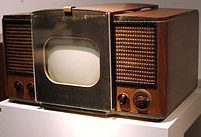
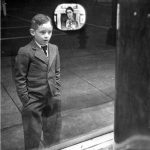 These days, nearly every household in the United States, if not the world has one, and those who don’t, have likely chosen to walk away from the television. And we aren’t even tied to our homes to watch television now. We can watch it from our computers or even our cell phones. Wow!! How far we have come. News is only new for a few seconds, and by the time stories come out in the paper, they have already been read on the internet. Before long, I’m sure the newspaper will become obsolete…if it hasn’t already.
These days, nearly every household in the United States, if not the world has one, and those who don’t, have likely chosen to walk away from the television. And we aren’t even tied to our homes to watch television now. We can watch it from our computers or even our cell phones. Wow!! How far we have come. News is only new for a few seconds, and by the time stories come out in the paper, they have already been read on the internet. Before long, I’m sure the newspaper will become obsolete…if it hasn’t already.
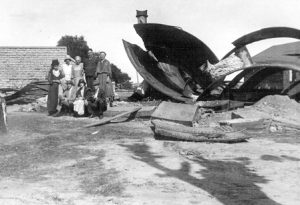
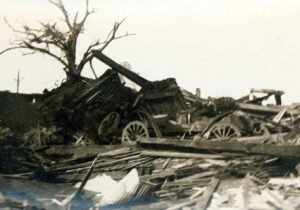 Over the centuries, tornadoes have managed to wreak havoc on various areas of the world, not to mention the thousands of lives they have taken. With advancements in the early warning systems and on weather conditions, the deaths have decreased, but in 1920, no such systems existed. It was March 28, 1920…Palm Sunday, when at least 37 tornadoes, 31 of which were significant, raged across the Midwest and Deep South states. The tornadoes left more than 380 dead, as well as at least 1,215 injured. Many communities and outlying farmers alike were caught off guard as the storms moved to the northeast at speeds that reached over 60 miles per hour. Georgia saw most of the fatalities with over 200 deaths. Indiana had 56 deaths and Ohio had 55, while the other states saw fewer fatalities. Without ways to monitor the tornadoes, very little is known about many of the specific tornadoes that occurred.
Over the centuries, tornadoes have managed to wreak havoc on various areas of the world, not to mention the thousands of lives they have taken. With advancements in the early warning systems and on weather conditions, the deaths have decreased, but in 1920, no such systems existed. It was March 28, 1920…Palm Sunday, when at least 37 tornadoes, 31 of which were significant, raged across the Midwest and Deep South states. The tornadoes left more than 380 dead, as well as at least 1,215 injured. Many communities and outlying farmers alike were caught off guard as the storms moved to the northeast at speeds that reached over 60 miles per hour. Georgia saw most of the fatalities with over 200 deaths. Indiana had 56 deaths and Ohio had 55, while the other states saw fewer fatalities. Without ways to monitor the tornadoes, very little is known about many of the specific tornadoes that occurred.
Early in the morning of March 28th, severe thunderstorms began developing in Missouri, moving quickly to the northeast towards Chicago, Illinois. The first tornado injured five people 35 miles southeast of Springfield, Missouri, in Douglas County. This first tornado was a warning of things to come as the morning went on and the atmosphere began to destabilize, due to the abundance of sunshine that preceded the cold front in the warm sector, which covered the lower Great Lakes region extending southward, well past the Ohio River Valley. According to meteorologist and weather historian Charles Merlin Umpenhour, the climatic conditions on Palm Sunday 1920 were favorable for all the atmospheric ingredients to come together that were needed to create the classic setup for long-track tornadoes. The forecasting…or communications technology and public awareness about Severe Weather was nearly nonexistent in 1920. That technology would not begin for another 33 years, when the US Weather Bureau implemented its Public Watch.
The residents of the Great Lakes region and Ohio Valley areas, had as their only source of weather information, the rather vague forecasts that were issued in the local newspaper the day before or by word of mouth. The use of the word “tornado” was strictly prohibited in public weather forecasting until the 1950s because of the fear and panic it might cause. This policy would come under fire in the years to come especially after the Tri-State Tornado in 1925 that stands today as the deadliest tornado in American history…as it should have. It would be insane not to let the people know of such deadly weather, simply because someone might get scared. That really is the point of it. To “scare” people into action!! It saves lives.
Weather forecasters and the public alike in the Chicago, Dayton, Fort Wayne, Lansing, South Bend, and Toledo areas were unaware of the likelihood of a significant tornado outbreak that would follow a beautiful Palm Sunday afternoon. The weather maps in use in March 1920 showed a rather large and deep cyclone over northern Iowa, and they knew it would be moving across central Lower Michigan by nightfall with a cold front right behind it. Meteorologists knew rain showers, and very likely thundershowers, were a good possibility, but were unaware that the helicity (which is a property of a moving fluid which represents the potential for helical flow…or a flow which follows the pattern of a corkscrew to evolve. Helicity is proportional to the strength of the 
 flow, the amount of vertical wind shear, and the amount of turning in the flow known as a vorticity), the lifted index, and upper level winds which were being guided by a strong jet stream with a probable negative tilt. When all that is put together, it creates conditions that are favorable for the development of tornadoes, and thereby, a seriously dangerous situation. Had the people known all that in 1920, perhaps most of the lives lost, could have been saved.
flow, the amount of vertical wind shear, and the amount of turning in the flow known as a vorticity), the lifted index, and upper level winds which were being guided by a strong jet stream with a probable negative tilt. When all that is put together, it creates conditions that are favorable for the development of tornadoes, and thereby, a seriously dangerous situation. Had the people known all that in 1920, perhaps most of the lives lost, could have been saved.
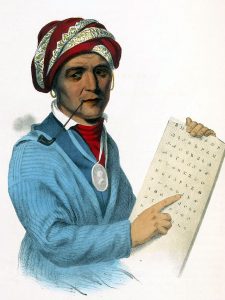 The Indian tribes in the United States had a spoken language, but in the early years they had no real need for a written language, other than hieroglyphics. At some point, a young Cherokee man named Sequoyah noticed something about the men in Andrew Jackson’s platoon, while he and some other Cherokee men were volunteering in the fight against the British in the War of 1812. In dealing with the Anglo soldiers and settlers, Sequoyah became intrigued by their “talking leaves” or printed books. Sequoyah realized that somehow the “talking leaves” recorded human speech. In a brilliant leap of logic, Sequoyah comprehended the basic nature of symbolic representation of sounds and in 1809 he began working on a similar system for the Cherokee language. Little did Sequoyah know that his work would change things, and in fact, change life for the Cherokee people. Still, it was not without it’s downside. Sequoyah was ridiculed and misunderstood by most of the Cherokee. Nevertheless, he made slow progress until he came up with the idea of representing each syllable in the language with a separate written character. Finally, he perfected his syllabary of 86 characters, a system that could be mastered in less than week. After obtaining the official endorsement of the Cherokee leadership, Sequoyah’s invention was soon adopted throughout the Cherokee nation.
The Indian tribes in the United States had a spoken language, but in the early years they had no real need for a written language, other than hieroglyphics. At some point, a young Cherokee man named Sequoyah noticed something about the men in Andrew Jackson’s platoon, while he and some other Cherokee men were volunteering in the fight against the British in the War of 1812. In dealing with the Anglo soldiers and settlers, Sequoyah became intrigued by their “talking leaves” or printed books. Sequoyah realized that somehow the “talking leaves” recorded human speech. In a brilliant leap of logic, Sequoyah comprehended the basic nature of symbolic representation of sounds and in 1809 he began working on a similar system for the Cherokee language. Little did Sequoyah know that his work would change things, and in fact, change life for the Cherokee people. Still, it was not without it’s downside. Sequoyah was ridiculed and misunderstood by most of the Cherokee. Nevertheless, he made slow progress until he came up with the idea of representing each syllable in the language with a separate written character. Finally, he perfected his syllabary of 86 characters, a system that could be mastered in less than week. After obtaining the official endorsement of the Cherokee leadership, Sequoyah’s invention was soon adopted throughout the Cherokee nation.
Finally, it was time for the next step. The General Council of the Cherokee Nation decided to purchase a 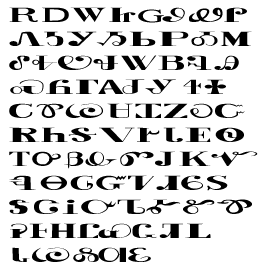 printing press. Their goal was to produce a newspaper in the Cherokee language. When the Cherokee-language printing press arrived on this day, February 21, 1828, the lead type was based on Sequoyah’s syllabary. Within months, the first Indian language newspaper in history appeared in New Echota, Georgia. It was called the Cherokee Phoenix. The Cherokee tribe was one of what the Americans called the “five civilized tribes” and they were native to the American Southeast. The Cherokee had long ago decided to embrace the United States’ program of “civilizing” Indians in the years after the Revolutionary War. In the minds of Americans, Sequoyah’s syllabary showed the Cherokee desire to fit into their dominant Anglo world. The Cherokee used their new press to print a bilingual version of the republican constitution. They also took many other steps to assimilate Anglo culture and practice while still preserving some aspects of their traditional language and beliefs. The press worked well, but would have been useless had it not been for the extraordinary work of Sequoyah.
printing press. Their goal was to produce a newspaper in the Cherokee language. When the Cherokee-language printing press arrived on this day, February 21, 1828, the lead type was based on Sequoyah’s syllabary. Within months, the first Indian language newspaper in history appeared in New Echota, Georgia. It was called the Cherokee Phoenix. The Cherokee tribe was one of what the Americans called the “five civilized tribes” and they were native to the American Southeast. The Cherokee had long ago decided to embrace the United States’ program of “civilizing” Indians in the years after the Revolutionary War. In the minds of Americans, Sequoyah’s syllabary showed the Cherokee desire to fit into their dominant Anglo world. The Cherokee used their new press to print a bilingual version of the republican constitution. They also took many other steps to assimilate Anglo culture and practice while still preserving some aspects of their traditional language and beliefs. The press worked well, but would have been useless had it not been for the extraordinary work of Sequoyah.
Sequoyah was born about 1770 in Tuskegee, Cherokee Nation, near present day Knoxville, Tennessee. He died 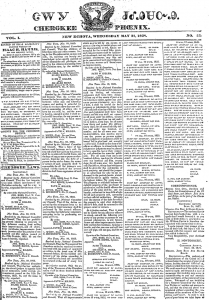 August 1843 at about 72 or 73, in San Fernando, Tamaulipas, Mexico. His name in English is George Gist or George Guess, which I find to be…well, crazy. Why was it necessary to butcher his name. Sequoyah was a Cherokee silversmith by trade, but his biggest claim to fame was the creation of written Cherokee. In 1821, when he completed his independent creation of a Cherokee syllabary, he successfully made reading and writing in Cherokee possible. This was one of the very few times in recorded history that a member of a pre-literate people created an original, effective writing system. After seeing its worth, the people of the Cherokee Nation rapidly began to use his syllabary and officially adopted it in 1825. Their literacy rate quickly surpassed that of surrounding European-American settlers. In recognition of his service, the Cherokee Nation voted Sequoyah an annual allowance in 1841. He died two years later on a trip to San Fernando, seeking Cherokee to return to Oklahoma with him. The giant California redwood tree, Sequoia, was named after him.
August 1843 at about 72 or 73, in San Fernando, Tamaulipas, Mexico. His name in English is George Gist or George Guess, which I find to be…well, crazy. Why was it necessary to butcher his name. Sequoyah was a Cherokee silversmith by trade, but his biggest claim to fame was the creation of written Cherokee. In 1821, when he completed his independent creation of a Cherokee syllabary, he successfully made reading and writing in Cherokee possible. This was one of the very few times in recorded history that a member of a pre-literate people created an original, effective writing system. After seeing its worth, the people of the Cherokee Nation rapidly began to use his syllabary and officially adopted it in 1825. Their literacy rate quickly surpassed that of surrounding European-American settlers. In recognition of his service, the Cherokee Nation voted Sequoyah an annual allowance in 1841. He died two years later on a trip to San Fernando, seeking Cherokee to return to Oklahoma with him. The giant California redwood tree, Sequoia, was named after him.
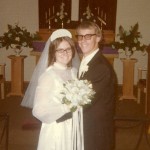 I met Bob while I was a senior in high school, and we were married a little over a year after graduation. After the wedding, we took honeymoon trip to Estes Park and the Rocky Mountain National Park. Bob and I had a wonderful honeymoon, and while we were gone, my parents took care of our cat.
I met Bob while I was a senior in high school, and we were married a little over a year after graduation. After the wedding, we took honeymoon trip to Estes Park and the Rocky Mountain National Park. Bob and I had a wonderful honeymoon, and while we were gone, my parents took care of our cat.
When we came home, we opened the front door to find that a few things had changed around our house. Our first clue was when we turned on the light and there was something on the switch…shaving cream. Stepping into the living room, we saw that there were torn newspapers all over the floor…and our cat had been having a great time shredding them. So we cleaned things up, laughing about the trick my parents had pulled off. Both our families are teasers and pranksters, so this was nothing new to us.
Then, I started to make dinner. We were going to have fried chicken…one of my favorite dishes, and as it cooked it smelled wonderful. As I was preparing the side dishes, a found that we had another surprise in store for us. All of the labels on our canned goods had been removed, so the side dishes were going to be a bit of a surprise too. In the end, we had fried chicken with mashed potatoes and gravy, and peaches. Now that doesn’t sound too bad, until you add that fact that I like salt, so I used a generous amount on the chicken, and as we bit into it, we discovered that the salt and sugar had been switched. Bob was such a good sport. He told me it wasn’t so bad, and ate at least two pieces of chicken. Thankfully we had used a packaged gravy, so it was good…of course the potatoes were a little sweet. All in all, it wasn’t too bad, and nothing went to waste. Again, we laughed about the whole thing.
The final prank was discovered when we went to bed that night. There was a cup of rice over our door, so my parents got to throw the final handful of rice to commemorate our marriage. They had also short sheeted the bed…which I’m sure you can figure out, and there were a few crackers in there that needed to be vacuumed out, but the funniest thing was the fact that there were a selection of bells, including a cow bell tied to the bed springs…so I’m sure you get the picture on that one. We were too tired to remove those until the next day, so it wasn’t a quiet night, but we did get…some sleep.
I suppose some people might think our homecoming was a mean trick, but we thought it was totally funny, and it has been a funny memory that we have had for the last 36 years. I wonder how many other people can tell you all of the details of that first day home from their honeymoon.

